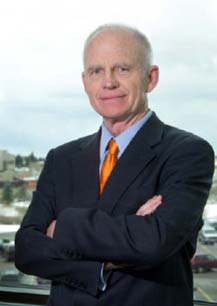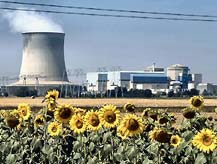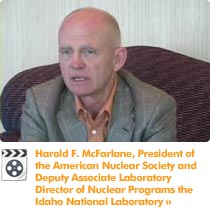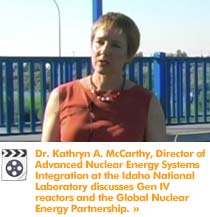

One of the biggest impediments to the nuclear power industry in the past was the separate construction and operational licensing of nuclear plants. When public opinion turned sour in the ’70s and ‘80s, a number of plants under construction or expanding were never granted their operating license due to public outcry.
 As president of the American Nuclear Society, Harold McFarlane sees public acceptance of nuclear energy as a function of improved math and science education.
As president of the American Nuclear Society, Harold McFarlane sees public acceptance of nuclear energy as a function of improved math and science education. As a result, very few power companies were willing to invest in new construction, if in the end they were prevented from operating. This changed in 1992 with the passing of the Energy Policy Act (Part 52 of the Code of Federal Regulations), which provides for a combined construction/operating license process that allows applicants to apply for a single license authorizing both the construction and operation of a nuclear power plant.
“The U.S., Congress and the Nuclear Regulatory Commission have dealt with the regulatory hurdles,” says McFarlane. “They have established a framework that they believe is going to work adequately, and that will be tested here by the end of the decade. I’m pretty optimistic about that.”
As for public opinion, McFarlane holds even more hope. “We’re actually starting from a pretty good base -- about 70 percent of the U.S. public right now really is in favor of using nuclear energy as a part our energy portfolio,” he declares. “It shows an increasing awareness of the overall energy situation and I think we’re making progress on that front.”
McFarlane believes that much of the past resistance to nuclear power has been due to the general public’s lack of understanding of the science surrounding nuclear power. “It’s all tied up with the issue of science and math education that we hear so much about these days,” he adds. “What we find in the opinion polls, is the more people know about nuclear power the more likely they are to support it.”
Path to Nuclear Power
All commercial nuclear plants in the U.S. are based on second generation, or Gen II, reactor designs. While these current Gen II plants will continue to operate for at least several more decades, the future of nuclear power does not lie with current Gen II reactors -- nor even with the interim Gen III and Gen III+ designs planned or being built. Instead, it relies on the next generation of reactors -- the Gen IVs.
 Built in 1985, the Enrico Fermi Nuclear Generating Station near Detroit, Michigan, is representative of Gen II reactors. Like most Gen IIs, Fermi’s original operating license was for 40 years. License extensions can stretch the plant’s operating life by another 10 to 20 years.
Built in 1985, the Enrico Fermi Nuclear Generating Station near Detroit, Michigan, is representative of Gen II reactors. Like most Gen IIs, Fermi’s original operating license was for 40 years. License extensions can stretch the plant’s operating life by another 10 to 20 years.As part of the push toward national energy security, the National Energy Policy issued by the Bush Administration in 2001 calls for development of advanced nuclear fuel cycles, next generation reactor technologies, and advanced reprocessing and fuel treatment technologies.
Part of this effort has been the establishment of the Gen IV International Forum and the Global Nuclear Energy Partnership. It is hoped that these programs will not only help current nuclear-capable countries benefit from their existing nuclear energy capability, but also bring affordable and proliferation-free nuclear power to the rest of the world.
Despite the goals set by the U.S. government, financial backing for the development of advanced nuclear technologies has been slow in coming, according to McFarlane. “There is authorization to proceed with it, but there isn’t a lot of funding,” he explains. “There are still some technical issues that have to be resolved.
“I think to make that happen we really need commercial interest to bite off a big chunk of the final development costs. I don’t think the government is really prepared to do that,” he says. Again, McFarlane is optimistic about the future of nuclear power and the potential of the Gen IV reactors. “My whole feeling on this has changed in the last six months, partly as a result of going around to a lot of places and talking to people,” he continues, “There’s a lot of interest in Gen IV.”
Entire contents © 2006 Corland Publishing. Use of editorial content without permission is strictly prohibited. All Rights Reserved. Privacy Policy Legal Contact Us. Site developed by ICON.




